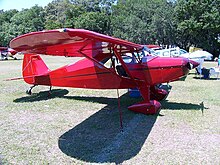| PA-16 Clipper | |
|---|---|
 Piper PA-16 Clipper in flight Piper PA-16 Clipper in flight | |
| General information | |
| Type | PA-16 Clipper |
| Manufacturer | Piper Aircraft |
| Number built | 736 |
| History | |
| Manufactured | only in 1949 |
| Introduction date | 1949 |
| First flight | 1947 |
| Variants | Piper PA-20 Pacer |
The Piper PA-16 Clipper is an extended fuselage model of the PA-15 Vagabond. Both models were designed in 1947 for the same reason – Piper Aircraft found itself in dire financial straits and needed to create new, competitive models using existing parts and tooling. The result was the Vagabond, essentially a side-by-side version of the tandem J-3 Cub credited with saving the company.
Design and development
The PA-16 Clipper is a stretched and refined version of the Vagabond intended to seat four people (or "two-and-a-half to three" as often told by Clipper pilots). It is equipped with an extra wing tank, added doors to accommodate the new seating, and a Lycoming O-235, the same engine that would later power the Cessna 152. The PA-16 Clipper retained the control sticks that had up to that point been common in aircraft derived from the "Cub" family.
In 1949, the Clipper sold for $2995. The average four-place airplane on the market at that time cost over $5000. Only 736 Clippers were built in the one year of production before Piper changed to the Piper PA-20 Pacer.
Pan Am Airlines, which traditionally called its famous luxury airliners "Clippers", took offense at Piper using the name for its light aircraft. As a result of this pressure Piper further refined the model, adding wing flaps, further fuel tanks and replaced the control sticks with yokes. A more powerful Lycoming O-290 125 hp engine was installed and this model became the Piper PA-20 Pacer.
Operational history
Despite the low number of aircraft built, according to the Federal Aviation Administration, in April 2018 there were still 303 examples in service in the United States.
Specifications (PA-16)


Data from Plane and Pilot:1978 Aircraft Directory and Fonden Danmarks Flymuseum.
General characteristics
- Crew: one
- Capacity: three passengers (798 lb (362 kg) useful load)
- Length: 20 ft 1 in (6.12 m)
- Wingspan: 29 ft 3 in (8.92 m)
- Height: 6 ft 2 in (1.88 m)
- Empty weight: 850 lb (385 kg)
- Gross weight: 1,650 lb (750 kg)
- Max takeoff weight: 1,650 lb (748 kg)
- Powerplant: 1 × Lycoming O-235 with cruise pitch propeller, 115 hp (86 kW)
Performance
- Maximum speed: 109 kn (125 mph, 203 km/h)
- Cruise speed: 102 kn (117 mph, 188 km/h)
- Stall speed: 43 kn (50 mph, 80 km/h)
- Never exceed speed: 122 kn (140 mph, 225 km/h)
- Range: 417 nmi (480 mi, 778 km)
- Service ceiling: 11,000 ft (3,385 m)
- Rate of climb: 580 ft/min (2.9 m/s)
- Power/mass: 0.070 hp/lb (0.115 kW/kg)
Avionics
Originally none were fitted. Many now have VHF Nav-com radios, GPS and transponders installed.
See also
Related development
Aircraft of comparable role, configuration, and era
References
- Notes
- ^ Plane and Pilot: 1978 Aircraft Directory, page 59. Werner & Werner Corp Publishing, 1978. ISBN 0-918312-00-0
- ^ Fonden Danmarks Flymuseum (n.d.). "Piper PA-16 Clipper". Archived from the original on 9 October 2007. Retrieved 10 December 2007.
{{cite web}}: CS1 maint: year (link) - Peperell 1987, p. 65
- "FAA Registry – Piper PA-16". Federal Aviation Administration. Archived from the original on 21 April 2018. Retrieved 21 April 2018.
- Bibliography
- Piper's Golden Age by Alan Abel, Drina Welch Abel, and Paul Matt
- The Pilot's Guide to Affordable Classics by Bill Clarke
- Peperell, Roger W; Smith, Colin M (1987). Piper Aircraft and their forerunners. Tonbridge, Kent, England: Air-Britain. ISBN 0-85130-149-5.
External links
 Media related to Piper PA-16 Clipper at Wikimedia Commons
Media related to Piper PA-16 Clipper at Wikimedia Commons
| Piper aircraft | |||||||||||||
|---|---|---|---|---|---|---|---|---|---|---|---|---|---|
| Company Numerical designations |
| ||||||||||||
| Names |
| ||||||||||||
| Military designations |
| ||||||||||||
| Piper Cub family | |||||||||||||
|---|---|---|---|---|---|---|---|---|---|---|---|---|---|
| Aircraft |
| ||||||||||||
| Military designations |
| ||||||||||||
| Foreign variants |
| ||||||||||||